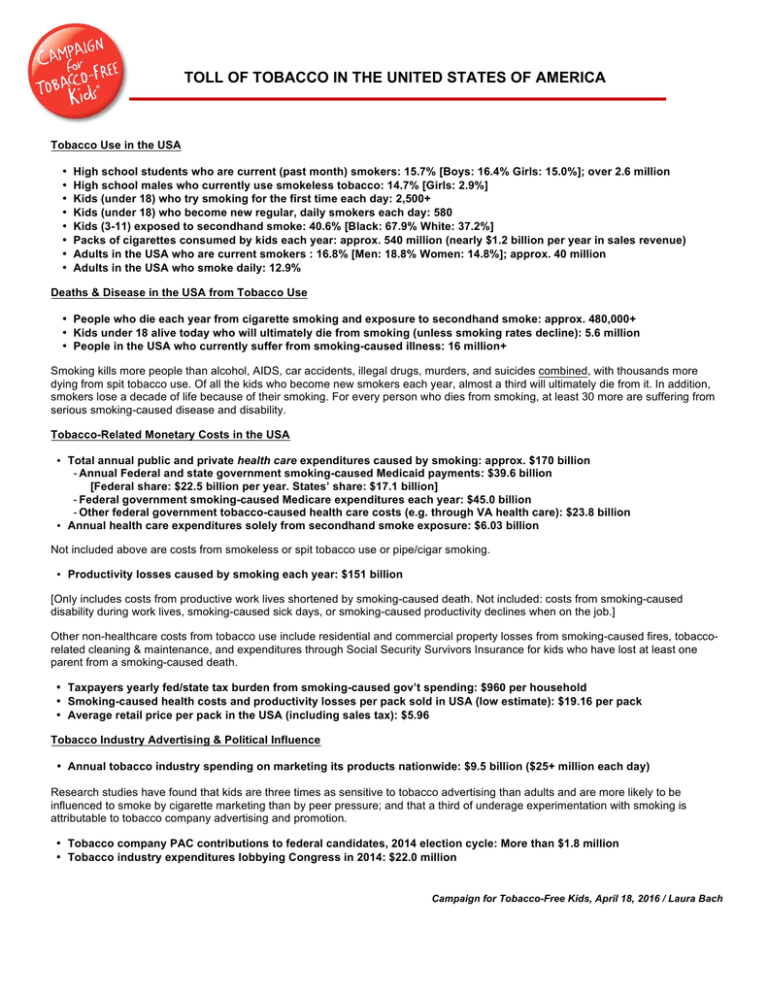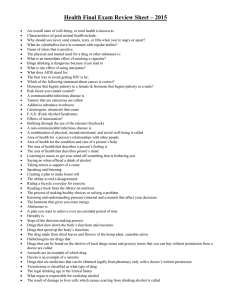TOLL OF TOBACCO IN THE UNITED STATES OF AMERICA
advertisement

TOLL OF TOBACCO IN THE UNITED STATES OF AMERICA Tobacco Use in the USA • • • • • • • • High school students who are current (past month) smokers: 15.7% [Boys: 16.4% Girls: 15.0%]; over 2.6 million High school males who currently use smokeless tobacco: 14.7% [Girls: 2.9%] Kids (under 18) who try smoking for the first time each day: 2,500+ Kids (under 18) who become new regular, daily smokers each day: 580 Kids (3-11) exposed to secondhand smoke: 40.6% [Black: 67.9% White: 37.2%] Packs of cigarettes consumed by kids each year: approx. 540 million (nearly $1.2 billion per year in sales revenue) Adults in the USA who are current smokers : 16.8% [Men: 18.8% Women: 14.8%]; approx. 40 million Adults in the USA who smoke daily: 12.9% Deaths & Disease in the USA from Tobacco Use • People who die each year from cigarette smoking and exposure to secondhand smoke: approx. 480,000+ • Kids under 18 alive today who will ultimately die from smoking (unless smoking rates decline): 5.6 million • People in the USA who currently suffer from smoking-caused illness: 16 million+ Smoking kills more people than alcohol, AIDS, car accidents, illegal drugs, murders, and suicides combined, with thousands more dying from spit tobacco use. Of all the kids who become new smokers each year, almost a third will ultimately die from it. In addition, smokers lose a decade of life because of their smoking. For every person who dies from smoking, at least 30 more are suffering from serious smoking-caused disease and disability. Tobacco-Related Monetary Costs in the USA • Total annual public and private health care expenditures caused by smoking: approx. $170 billion - Annual Federal and state government smoking-caused Medicaid payments: $39.6 billion [Federal share: $22.5 billion per year. States’ share: $17.1 billion] - Federal government smoking-caused Medicare expenditures each year: $45.0 billion - Other federal government tobacco-caused health care costs (e.g. through VA health care): $23.8 billion • Annual health care expenditures solely from secondhand smoke exposure: $6.03 billion Not included above are costs from smokeless or spit tobacco use or pipe/cigar smoking. • Productivity losses caused by smoking each year: $151 billion [Only includes costs from productive work lives shortened by smoking-caused death. Not included: costs from smoking-caused disability during work lives, smoking-caused sick days, or smoking-caused productivity declines when on the job.] Other non-healthcare costs from tobacco use include residential and commercial property losses from smoking-caused fires, tobaccorelated cleaning & maintenance, and expenditures through Social Security Survivors Insurance for kids who have lost at least one parent from a smoking-caused death. • Taxpayers yearly fed/state tax burden from smoking-caused gov’t spending: $960 per household • Smoking-caused health costs and productivity losses per pack sold in USA (low estimate): $19.16 per pack • Average retail price per pack in the USA (including sales tax): $5.96 Tobacco Industry Advertising & Political Influence • Annual tobacco industry spending on marketing its products nationwide: $9.5 billion ($25+ million each day) Research studies have found that kids are three times as sensitive to tobacco advertising than adults and are more likely to be influenced to smoke by cigarette marketing than by peer pressure; and that a third of underage experimentation with smoking is attributable to tobacco company advertising and promotion. • Tobacco company PAC contributions to federal candidates, 2014 election cycle: More than $1.8 million • Tobacco industry expenditures lobbying Congress in 2014: $22.0 million Campaign for Tobacco-Free Kids, April 18, 2016 / Laura Bach Sources of Information for Tobacco’s Toll in the USA Youth tobacco use. 2013 National Youth Risk Behavior Survey (YRBS). The 2011 YRBS found that 18.1% of high school students smoked and 12.8% of high school males used smokeless tobacco. Current smoker defined as having smoked in the past month. The CDC also released the 2015 National Youth Tobacco Survey in 2016 but we rely on the YRBS for national tobacco use rates because the CDC continues to rely on the YRBS as its main measure of trends. See, also, Inst. for Social Research, Univ. of Mich., Monitoring the Future Studies, http://monitoringthefuture.org/new.html. Youth initiation. Substance Abuse and Mental Health Services Administration (SAMHSA), HHS, Results from the 2014 National Survey on Drug Use and Health, NSDUH: Summary of National Findings http://www.samhsa.gov/data/sites/default/files/NSDUH-DetTabs2014/NSDUH-DetTabs2014.pdf. Secondhand smoke exposure. Centers for Disease Control and Prevention (CDC), “Vital Signs: Disparities in Nonsmokers’ Exposure to Secondhand Smoke – United States, 19992012,” Morbidity and Mortality Weekly Report, February 3, 2015. Packs consumed by kids. Healton, C, et al., “Youth smoking prevention and tobacco industry revenue,” Tobacco Control 15:103-106, 2006. See, also, DiFranza, J & Librett, J, “State and Federal Revenues from Tobacco Consumed by Minors,” American Journal of Public Health 89(7):1106-1108, July 1999; Cummings, et al., “The Illegal Sale of Cigarettes to US Minors: Estimates by State,” American Journal of Public Health 84(2):300-302, February 1994. Adult smoking. CDC, “Current Cigarette Smoking Among Adults - United States, 2005-2014,” MMWR 64(44):1233-1240, November 13, 2015, http://www.cdc.gov/mmwr/pdf/wk/mm6444.pdf. National prevalence of daily adult smokers calculated based on percent of smokers reporting daily use. Smoking deaths and disease. CDC, “The Health Consequences of Smoking – 50 Years of Progress A Report of the Surgeon General 2014,” http://www.surgeongeneral.gov/library/reports/50-years-of-progress/50-years-of-progress-by-section.html; Smoking-related disease and disability from CDC, Smoking & Tobacco Use, http://www.cdc.gov/tobacco/data_statistics/fact_sheets/fast_facts/index.htm#toll. Smoking-caused costs. Xu, X et al., “Annual Healthcare Spending Attributable to Cigarette Smoking: An Update,” Am J Prev Med, 2014. HHS, The Health Consequences of Smoking – 50 Years of Progress A Report of the Surgeon General, 2014. Federal gov’t reimburses the states, on average, for 56.8% of their Medicaid expenditures. National health care costs are in 2010 dollars. SHS Costs. Health care costs updated to 2009 dollars, based on data in Behan, DF, et al., Economic Effects of Environmental Tobacco Smoke, Society of Actuaries, March 31, 2005, https://www.soa.org/Research/Research-Projects/LifeInsurance/research-economic-effect.aspx. Productivity costs. HHS, The Health Consequences of Smoking – 50 Years of Progress A Report of the Surgeon General, 2014. Productivity losses in 2009 dollars. Tobacco tax burden. Smoking-caused federal/state tax burden equals listed government expenditures plus 3% of total tobacco-caused health costs to account for unlisted federal/state smoking costs, and are in 2010 dollars. Xu, X et al., “Annual Healthcare Spending Attributable to Cigarette Smoking: An Update,” Am J Prev Med, 2014. State tax burden is based on data from CDC, Best Practices for Comprehensive Tobacco Control Programs, 2014; CDC, Data Highlights 2006 CDC, “Medical Care Expenditures Attributable to Smoking—United States, 1993,” MMWR 43(26):1-4, July 8, 1994. U.S. Census Bureau is used for household data. Per pack health and productivity costs calculated using 2010 national pack sales from U.S. Alcohol and Tobacco Tax and Trade Bureau. Average retail price per pack. Orzechowski & Walker, The Tax Burden on Tobacco, 2014, and adjustments for industry price promotions, price increases, and inflation. See the following for examples of studies on non-healthcare costs from tobacco use. Fire costs. Hall, Jr., JR, National Fire Protection Association, The Smoking-Material Fire Problem, November 2007, http://www.nfpa.org/assets/files//PDF/OS.SmokingMaterials.pdf; U.S. Fire Administration/National Fire Data Center, U.S. Federal Emergency Management Agency (FEMA), Residential Smoking Fires and Casualties, Topical Fire Research Series 5(5), June 2005, http://www.usfa.fema.gov/downloads/pdf/tfrs/v5i5.pdf. Cleaning and maintenance costs. Mudarri, D, U.S. Environmental Protection Agency, Costs and Benefits of Smoking Restrictions: An Assessment of the Smoke-Free Environment Act of 1993 (H.R. 3434), submitted to Subcommittee on Health and the Environment; Energy and Commerce Committee, U.S. House of Representatives, April 1994. CDC, Making Your Workplace Smokefree: A Decision Maker’s Guide, 1996. Other nonhealth costs. U.S. Dept. of the Treasury, Economic Costs of Smoking in the U.S. and the Benefits of Comprehensive Tobacco Legislation, 1998; Chaloupka, FJ & Warner, KE, “The Economics of Smoking,” in Culyer, A & Newhouse, J, (eds), The Handbook of Health Economics, 2000; CDC, MMWR 46(44), November 7, 1997. Smoking & SSSI costs: Leistikow, B, et al., “Estimates of Smoking-Attributable Deaths at Ages 15-54, Motherless or Fatherless Youths, and Resulting Social Security Costs in the United States in 1994,” Preventive Medicine 30(5):353-360, May 2000. Tobacco marketing. U.S. Federal Trade Commission (FTC). Cigarette Report for 2013, 2016, https://www.ftc.gov/system/files/documents/reports/federaltrade-commission-cigarette-report-2013/2013cigaretterpt.pdf; FTC, Smokeless Tobacco Report for 2013, 2016, https://www.ftc.gov/system/files/documents/reports/federal-trade-commission-smokeless-tobacco-report-2013/2013tobaccorpt.pdf [Data for top 5 manufacturers only]. See, also Campaign factsheet, Increased Cigarette Company Marketing Since the Multistate Settlement Agreement Went into Effect. Tobacco marketing studies. Pollay, R, et al., “The Last Straw? Cigarette Advertising and Realized Market Shares Among Youths and Adults,” Journal of Marketing 60(2):1-16, April 1996. Evans, N, et al., “Influence of Tobacco Marketing and Exposure to Smokers on Adolescent Susceptibility to Smoking,” Journal of the National Cancer Institute 87(20):1538-45, October 1995. Pierce, JP, et al., “Tobacco Industry Promotion of Cigarettes and Adolescent Smoking,” Journal of the American Medical Association 279(7):511-505, February 1998 [with erratum in JAMA 280(5):422, August 1998]. Tobacco industry political contributions, lobbying. Federal Election Commission. Center for Responsive Politics, http://www.opensecrets.org. All CDC MMWR's at http://www.cdc.gov/mmwr. Abstracts of many of the cited articles at PubMed, http://www.ncbi.nlm.nih.gov/entrez. Related Campaign Factsheets, available at http://www.tobaccofreekids.org or http://tobaccofreekids.org/research/factsheets.



